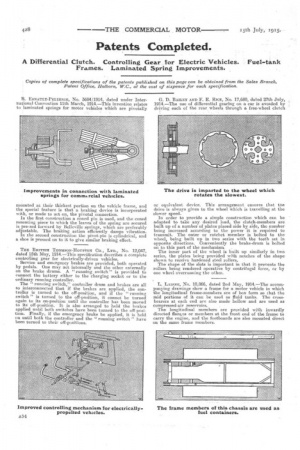A Differential Clutch. Controlling Gear for Electric Vehicles. Fuel-tank Frames. Laminated Spring Improvements.
Page 20

If you've noticed an error in this article please click here to report it so we can fix it.
Copies of complete specifications of the patents published on this page can be obtained from the Sales Branch, Patent Office, Holborn, W.C., at the cost of sixpence for each specification.
R. ESNAULT-PELTERIE, No. 3694/1914, dated under International Convention 11th March, 1914.—This invention relates to laminated springs for motor vehicles which are pivotally
mounted at their thickest portion on the vehicle frame, and the special feature is that a braking device is incorporated with, or made to act on the pivotal connection.
In the first construction a coned pin is used, and the coned mounting pieceto which the leaves of the spring are secured is pre-sed forward by Belleville springs, which are preferably adjustable. The braking action efficiently damps vibration.
In the second construction the pivot-pin is cylindrical, and a shoe is pressed on to it to give similar braking effect.
THE BRITISH THOMSON-HOUSTON CO., LTD., No. 12,047, dated' 15th May, 1914.—This specification describes a complete controlling gear for electrically-driven vehicles.
Service and emergency brakes are provided, both operated by pedals. One may act internally and the other externally on the brake drums. A "running switch" is provided to connect the battery either to the charging Bucket or to the ordinary running controller.
The " running switch," controller drum and brakes are all so interconnected that if the brakes are applied, the controller is turned to the off-position, and if the " running switch" is turned to the off-position, it cannot be turned again to its on-position until the controller ha 's been moved to its oft-position. It is also arranged to hold the brakes applied until both switches have been turned to the off-position. Finally, if the emergency brake be applied, it is held on until both the controller and the " running switch " have been turned to their off-positions.
Or. D. BAILEY AND F. E. RICE, No. 17,680, dated 27th July, 1914.—The use of differential gearing on a car is avoided by driving each of the rear wheels through a free-wheel clutch
or equivalent device. This arrangement ensures that the drive is always given to the wheel which is travelling at the slower speed_
In order to provide a simple construction which can be adapted to take any desired load, the clutch-members are built up of a number of plates placed side by side, the number being increased according to the power it is required to transmit. The outer or ratchet member is bolted to the wheel1 being built up in two series with the teeth set in opposite directions. Conveniently the brake-drum is bolted on to this part of the mechanism.
The inner part of the wheel is built up similarly in two series, the plates being provided with notches of the shape shown to receive hardened steel rollers.
The shape of the slots is important in that it prevents the rollers being rendered operative by centrifugal force, or by one wheel overrunning the other.
L. LAISNE, No. 10,866, dated 2ncl May, 1914.—The accompanying drawings show a frame for a. motor vehicle in which the longitudinal frame-members are of box form so that the mid portions of it can be used as fluid tanks. The crossbearers at each end are also made hollow and are used as compressed-air reservoirs. The longitudinal members are provided with inwardly directed flanges or members at the front end of the frame to carry the engine, and the footboards are also mounted direct on the same frame members.




















